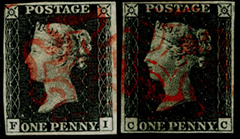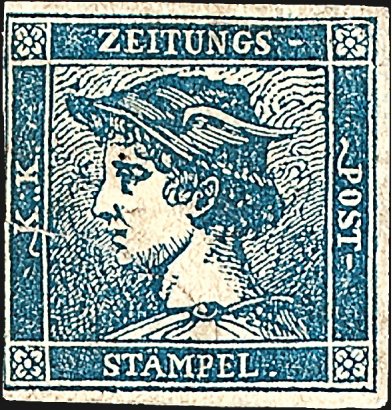 First Issues Collectors Club
of stamps and philatelic material
First Issues Collectors Club
of stamps and philatelic material
Home - Catalog - Categories - Index - Journal - Exhibits - Auctions - Forgeries - Join
 First Issues Collectors Club
of stamps and philatelic material
First Issues Collectors Club
of stamps and philatelic material
Home - Catalog - Categories - Index - Journal - Exhibits - Auctions - Forgeries - Join
| first issues > countries > austria |
↓ - Innovations
| Europe | 6 |
See also Austria-Hungary - Hungary
Imperforate, hand made paper, K.K.H.M in gutter or no watermark, typographed.
Printed by Vienna State Printing Works.
| Description | Color | # printed | # used | # remainder | Scott # | SG#† | Mi# | Y&T# |
|---|---|---|---|---|---|---|---|---|
| 1850 - 1854. Hand made paper. | ||||||||
1 Kreuzer |
yellow |
7.4 million | 7.4 million | 1, 1a, 1b, 1c, 1e | 1 | |||
2 Kreuzer |
black |
6.6 million | 6.6 million | 2, 2a, 2b, 2d, 2e | 2 | |||
3 Kreuzer |
red |
64.0 million | 64.0 million | 3, 3a, 3b, 3c, 3d | 3 | |||
6 Kreuzer |
brown |
46.6 million | 46.6 million | 4, 4a, 4c, 4d, 4e | 4 | |||
9 Kreuzer |
blue |
53.3 million | 53.3 million | 5, 5a, 5b, 5c, 5d, 5f, 5g | 5 | |||
| Total: | 177.9 million | 177.9 million | ||||||
| 1854 - 1858. Machine made paper. | ||||||||
1 Kreuzer |
yellow |
14.6 million | 11.8 million | 2.8 million | 1d, 1f, 1g, 1h, 1i, 1j | 6 | ||
2 Kreuzer |
black |
12.1 million | 9.8 million | 2.3 million | 2c | 7 | ||
3 Kreuzer |
red |
109.3 million | 88.5 million | 20.8 million | 3e, 3f | 8 | ||
6 Kreuzer |
brown |
71.9 million | 58.9 million | 13.0 million | 4b, 4f | 9 | ||
9 Kreuzer |
blue |
84.5 million | 69.4 million | 15.1 million | 5e, 5g | 10 | ||
| Total: | 292.4 million | 238.4 million | 54.0 million | |||||
| 1850 - 1858. Totals for all issues. | ||||||||
1 Kreuzer |
yellow |
22 million | 19.2 million | 2.8 million | 1 | |||
2 Kreuzer |
black |
18.7 million | 16.4 million | 2.3 million | 2 | |||
3 Kreuzer |
red |
173.3 million | 152.5 million | 20.8 million | 3 | |||
6 Kreuzer |
brown |
118.5 million | 105.5 million | 13 million | 4 | |||
9 Kreuzer |
blue |
137.8 million | 122.7 million | 15.1 million | 5 | |||
| Total: | 470.3 million | 416.3 million | 54 million | |||||
All issue quantities are approximate.
† Gibbons lists colour and typographic differences, but the sequencing is so different to Scott's that there is no sensble way to integrate the catalogues in detail.
Before 1867 the Austrian Empire included Hungary and Lombardy & Venetia. Lombardy & Venetia were acquired by Austria in 1815; Lombardy was lost in 1859, Venetia in 1866. Until 1867 Franz Josef was Emperor of Austria-Hungary. He then became Emperor of Austria and, separately, King of Hungary. A few functions (e.g. the War Department) remained Austria-Hungary.
The Hungarian part of the empire included several well known areas, among those Croatia-Slavonia, Serbia, Transylvania and what is now the Czech Republic.
Separate stamps were issued in 1850 for Lombardy & Venetia, since they had their own currency. These stamps were also valid in the rest of the empire. Austrian stamps were valid in all of the empire, except for Lombardy & Venetia!
In 1867 the establishment of a separate Hungarian Monarchy was agreed, and a separate stamp issue but with a common design (Scott #27-33) was used from June 1, 1867. Hungary began issuing their own design of stamps in 1871.
Detailed statistics for 1853 tells us that Austria, with 53.5% of the population, used 65% of the stamps; Hungary with 29% of the population used only 17.5% of the stamps. Lombardy & Venetia had both a population share and stamp usage of 17.5%. These differences can be attributed to the fact that litteracy rates varied in this large empire. When we remember that Lombardy & Venetia issued their own stamps, we see that approximately 27% of the common issue were used in Hungary. It is not unusual to find the first issue cancelled in Pesth, for example.
The stamps were printed in sheets of 240, with the addition of 16 so-called 'St. Andreas Kreutz', or St. Andrews crosses, arranged as 4 panes of 64 clichés. The four 'dummy' crosses in each pane ensured that a pane of stamps cost a multiple of Gulden, since there was 60 Kreuzer to a Gulden.
One million stamps in the value of 12 Kreuzer were also printed before the issue date. However, the postal rates were changed before March 26, 1850, rendering these stamps useless, and virtually all were destroyed. The new rate called for the hurried production of the blue 9 Kreuzer stamps.
The remainder of the first issue is assumed to consist almost entirely of the last printings. As a general rule stamps printed first were used first. These remainders were mostly burned in 1859.
The long validity and the different printings gave rise to great differences in color. When the yellow for the l Kreuzer stamp was too light, the printers turned the sheets and printed better stamps on the back. Thus the double-sided prints that are listed in the catalogs.
When the currency changed on November 1, 1858 new stamps were needed. Instead of 60 Kreuzer, one Gulden now equalled 100 Neu-Kreuzer.
Stamps of the Austro-Hungarian Monarchy were issued in 1867.
We owe a debt of gratitude to Andy Taylor of the Austrian Philatelic Society for his generous help in providing the data for this page. The data presented here are based on an article in the APS magazine 'Austria' #20: 'Statistics as an Aid to Plating the 1850 Issue' by Dr. P. F. von Stritzl.
Any errors in this presentation are solely the responsibility of the webmaster[s].
 |
| 1851 Sc-P1 SG-N11b |
Innovations
Austria invented the Newspaper stamp, allowing newspapers and journals to be sent at special, lower, rates. Newspaper stamps in general are often in short supply as the recipients tended to tear off and dispose of the label bearing the stamp, or (if the stamp was attached direct to the newspaper) bin the newspaper itself.
Sources: ScC, SGP2.
| FI ref: 16 | Page credit: JA/NB |
| Page created 19 Feb 2014 | Page updated 25-May-2017 |